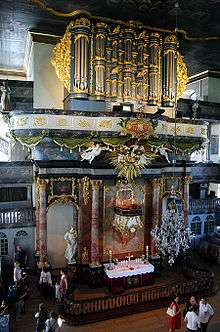Kongsberg
Kongsberg is a town in Buskerud. It is an old mining community that developed around the rich silver mines from the 1600s. Today the town is a high-tech centre in Norway and the mines are now only a great sight for visitors. Kongsberg is the gate to the great Numedal valley. There is also a nice winter sport resort in the hills of Kongsberg.
- Not to be confused with Kaliningrad, formerly known as Königsberg.

Understand
Kongsberg was founded in 1624, after silver was discovered in the hills. The Danish-Norwegian king recruited German miners to the mines. As result, Kongsberg in the 17th century was a "German" town. It was the second largest in Norway only rivaled by Bergen. Mining ceased in 1957. The name "Kongsberg" means something like "King's mounta" or "King's mining hills".
Kongsberg today is a centre for high-tech industry. Kongsberg also hosts the Norwegian mint, and all Norwegian coins since 1686 are produced in Kongsberg. Kongsberg was from its foundation a key town in Norway, thanks to the rich silver sources in the hills. Today it's merely a small town, but its rich past is seen, for instance, in Konsberg church, still Norway's largest church by number of seats. Kongsberg and Røros Churches are the two monumental churches of the 1700s.
Silver mines
- See also: Mining tourism
Unlike most other Norwegian towns, Kongsberg is not a port but resides in the valley next to the mines. The silver mines is a web of some 1000 km of tunnels, and 300 shafts, dug out during more than 300 years of production, and is a key historical monument. The mines cover an area of 30 square km, which also includes about 80 dams supplying water to the facilities. Unlike most mines, in the Kongsberg mines large chunks of pure silver were often found deep in the hard rock. More than 1 million kilograms of pure silver were extracted from these hills. The deepest shafts went 1000 meters underground. At its peak, the mines employed some 4000 people and were Norway's largest enterprise before the industrial era. A small train brings visitors a few kilometers into the mines (May 18 to August 31).
Røros and Kongsberg were the only towns in Norway that enjoyed the special bergstad (mining town) privileges.
Get in
By plane
- Oslo Airport, Gardermoen (OSL IATA) Driving distance to Gardermoen: about two hours. Train connections from Kongsberg.
- For more information on facilities at and around Oslo Airport, Gardermoen, see the Oslo Airport, Gardermoen article.
- Sandefjord Airport Torp (TRF IATA)
By rail
Trains between Oslo and Kristiansand passes Kongsberg. There is 23 trains a day between Oslo and Kongsberg. 🌍 Kongsberg stasjon, the main railway station is located at Schwabes gate 2 just north of the city centre.
By bus
"Timekspressen" Bus between Oslo and Notodden passes Kongsberg, every hour, every day.
Get around
Kongsberg is a compact town. So it is possible to walk. Kongsberg also has many cycling paths.
See


- 🌍 Sølvgruvene (Silvermines), Saggrenda (Situated 8 km west of the town.), e-mail: bergverksmuseet@bvm.museum.no. Guided tours in the old mines. A train brings the visitors 2300 metres into he mountain. Adult:140 kr, Students and seniors: 100 kr, Children: 80 kr.
- Norsk Bergverksmuseum (Mining Museum), Hytte gate 3, ☎ +47 32723200, e-mail: bergverksmuseet@bvm.museum.no. 18 May-31 Aug: Daily 10AM-5PM, 1 Sep-16 May: Tu-F: Noon-3PM, Sa,Su: Noon-4PM. Adults: 70kr, Students and seniors: 50kr, Children: 20kr.
- Lågdalsmuseet. Has a collection of old houses, and old things. Showing how life was in the town in old times. Adults: 40kr, Children: 10kr.
- 🌍 Kongsberg Church (Kongsberg kirke), Kirketorget 1, ☎ +47 32 86 60 30. Kongsberg's large church, one of Norway's largest, is a legacy from Kongsberg's important past. It was designed for 2400 seats, now seating is limited to 1100. The somewhat strict exterior conceals a rich rococco interior, the interior also reflects the particular mining society at Kongsberg. German professionals at the mines had a key impact on the design. The interior has several unusual features, such as the integration of the pulpit with the altar, the organ towering above. The largest chandelier is about 3 meters tall. The King's chambre is also a dominant feature of the interior.
Do
- Kongsberg Skisenter, ☎ +47 32717070, e-mail: kontor@kongsberg-skisenter.no. Skiing slopes.
- Kongsberg Jazzfestival. Early July.
Buy
- Stortorvet. Shopping mall
Eat
- Tastyasia, Storgaten 2, ☎ +47 32732155. Thai
- Big Horn Steakhouse, Thornesvei 4, ☎ +47 32723060, fax: +47 32723063, e-mail: kongsberg@bighorn.no. M-Th: 4PM-10PM, F: 4PM-11PM, Sa: 3PM-11PM, Su: 3PM-10PM. Steak restaurant with view of the river.
- Kongs Kina Restaurant, Nymoens Torg 18, ☎ +47 32733695. Chinese.
- Peppes Pizza, Nymoens torg 2, ☎ +47 22225555.
- Restaurant Fryd, Christian Augusts gate 2 (At Quality Hotel Grand), ☎ +47 32772800.
- Opsahlgården, Kirkegt. 10, ☎ +47 32764500, e-mail: post@opsahlgarden.no.
Drink
- Privat Cafe og Bar, Storgata 4, ☎ +47 32724400.
Sleep
Budget
- Kongsberg Vandrerhjem Bergmannen, Vinjes gate 1, ☎ +47 32732024.
- Pikersfoss Hyttegrend og Camping, Svendsplassveien 2, 3614 Kongsberg (About 8 km north of Kongsberg on Fv88), ☎ +47 91 19 07 41, e-mail: erikfred@online.no. 140kr/tent + 10kr/person.
Mid-range
- 🌍 Best Western Gyldenløve Hotell, Hermann Foss gate 1, ☎ +47 32865800.
- 🌍 Quality Hotel Grand, Christian Augusts gate 2, ☎ +47 32772800.
Connect
- Kongsberg Bibliotek (Kongsberg Public Library), Christian Augusts gate 1, ☎ +47 32866850, fax: +47 32731276, e-mail: kongsbib@kongsberg.folkebibl.no. Wireless internet for laptop and computers with internet access available.
Go next
- Numedal valley towards Geilo.
- Blefjell, great cross country skiing.
- Bolkesjø, great for hikingtrips and fishing.
- Rjukan, drive towards Geilo, and off to Road 37 to find historical town with many possible activities.